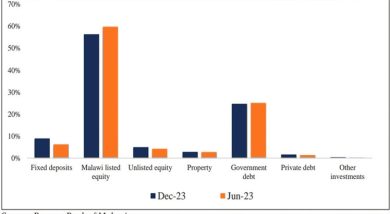MW ranks low on stock markets
Malawi’s capital market is among the most illiquid markets and characterised by low trade volumes and market turnover with ratios of close to zero, the World Bank has said.
In its recently published February 2020 edition of the Malawi – Mobilising Long-Term Finance for Infrastructure (Volume 2): Summary Report, the bank observed that the most liquid markets in the region are South Africa with a ratio of 33 percent, followed by Egypt (26 percent), Mauritius (9 percent), and Nigeria and Kenya, both at 6 percent while Tanzania, Zambia, Namibia, and Côte d’Ivoire have ratios of between one percent and four percent.

Reads the report in part: “The size of investors’ assets is larger than what the market in its current state can absorb. Market cap is currently 79 percent of institutional investors’ assets, and the annual stock market turnover stood at K46 billion, which is a small fraction [2.5 percent] of investors’ assets.
“As a result, investors generally buy-and-hold their equity investments, which contributes to market illiquidity. Under the circumstances Malawi faces the risk of an asset bubble,” it reads in part.
The bank observed that while listed equities are a preferred home for Malawian institutional investors, they are only a handful with only 15 listed stocks on the Malawi Stock Exchange (MSE) with total market capitalisation (market cap) of K1.5 trillion ($2 billion), which is equivalent to 25 percent of gross domestic product (GDP).
“Limited investment options in the formal capital markets are causing institutional investors to search for unlisted investment opportunities in the form of private debt and private equity. Recent data indicate that investors are reallocating assets from government securities to other asset classes given the recent decline in yields on government securities, but options are limited,” the report further reads.
World Bank figures show that in 2019, allocation of pension assets to listed equities, unlisted debt, and real estate increased by 52 percent, 48 percent, and 28 percent, respectively.
The institutional investors’ landscape in Malawi is characterised by 29 registered pension funds, of which 22 are private, six are quasi-public (public institutions or State-owned enterprises-linked funds), and one is a national public mandatory fund.
In addition, there are five life insurance companies, five portfolio managers and two collective investment schemes.
Total institutional investors’ assets (including non-pension funds and life insurance-related assets) stood at K 1.8 trillion ($2.5 billion) in 2019 or 32 percent of 2019 GDP, of which 85 percent were assets of pension funds and life insurance companies.
Market analyst Emmanuel Chokani observed earlier that the problem that Malawi has is that there is significant cash chasing few counters with issuers preferring accessing capital from the private placement debt market and also from banks and not from the listed debt capital market although some are not able to access them because of their risk profile.
“We estimate that K95 billion is being accessed,” he said.
An analysis by Chokani showed that since 1994, K85 billion has been raised on the MSE with K61 billion raised from initial public offers (IPOs) while K24 billion raised from rights issues.
Equity capital raising costs on the other hand have also been decreasing from highs of over 15 percent to 3.5 percent to 6.5 percent of total capital raised.
MSE chief executive officer John Kamanga observed that despite existence of alternative sources of finance, commercial banks have dominated financing.
He, however, said there is a mismatch in terms of maturity because clients borrow short-term to finance long-term projects which exerts financial pressure on firms and is a disadvantage in terms of their gearing rations.






One Comment